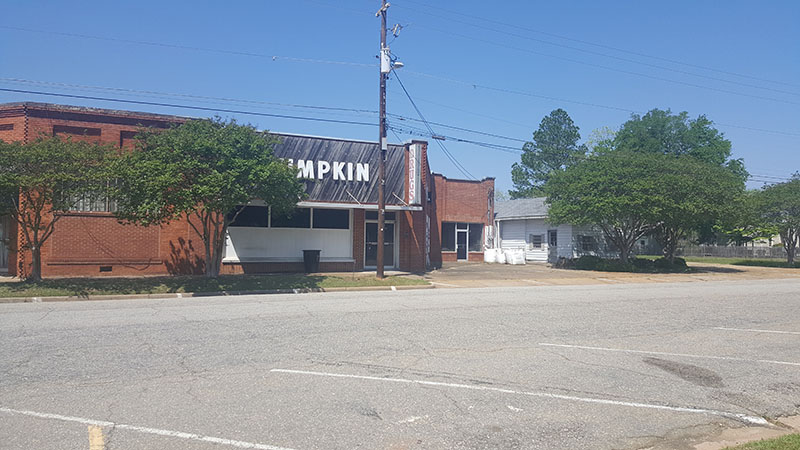Our friends at the Southern Poverty Law Center (SPLC) have created the Southeast Immigrant Freedom Initiative (SIFI) which offers legal support and representation to immigrants in federal detention in direct response to the travel bans created during the first 100 days of the Trump administration. Crystal Richardson, Legal Director of CSE’s Rapid Response Initiative, recently participated in the first phase of the project. She spent a week at Stewart Detention Center, a federal detention and immigration court in Lumpkin, Georgia. This blog describes her experiences. In May, Crystal will return to Lumpkin for the second phase of the SIFI project.
By Crystal Richardson, Legal Director, Rapid Response Initiative, Campaign for Southern Equality
In late April, I visited a tiny, little town called Lumpkin, Georgia. According to the 2013 Census, the population in Lumpkin is 30,918. It took me two planes and a 40-minute car ride to get to this peaceful town. But on a daily basis immigrants are being deported and families are being torn apart at Stewart Detention Center in Lumpkin. Stewart Detention Center houses both a detention facility and an immigration court. This facility is run by Nashville-based private prison corporation CoreCivic, formerly known as the Corrections Corporation of America.

The facility itself is very prison-like from the outside looking in, so I can only imagine what the experience is like for the respondents in the detention center. This Stewart Detention Center is unique in that it is an immigration court and detention center at the same facility. There is barbed-wire surrounding the facility like a compound and there are several secured doors that you must enter before you get inside. Everyone who enters this facility must go through the security operations including family members and attorneys.
Despite the rigidness of this facility, I felt that the staff at Stewart Detention Center were accommodating and understanding of what we were doing and why we were there. Out of the entire week, I only had to explain once what we were doing in the courtroom. Overall, I felt welcomed at the facility. For example, while I was waiting with the other volunteer attorneys for approval to observe the proceedings, the clerk came from behind the window just to update me on the number of proceedings available to view that day, as well as, an estimated wait time to enter the courtroom. I was extremely surprised by her friendliness.
On average, I saw about 30 respondents (the individuals being detained) each day, while I spent my week in Lumpkin. Approximately 12 of 30 respondents per day had attorneys. During the bond hearings, all of the respondents were given either what was referred to as a “high bond” (usually around $25,000) or a flat out “denial” of bond; most of the people I observed were Latino men from Mexico or Guatemala; and majority of the individuals were deported in less than 5 minutes.
Respondents stood before a judge who asked a series of questions to determine whether there was any form of relief for the respondent. I don’t know exactly what the “correct” answers are to these questions or whether there are “magic words” you can say to not get deported, but it seemed to me that if the respondents did not answer these questions using the “magic words,” then their fate was ultimately sealed – they would be deported. Even the respondents that qualified for some form of relief often declined, likely because they did not want to remain in the detention center any longer. When the judge presented options for relief, which was rare, in and of itself, their next question usually was “If I file a request for that type of relief, how long will it take to hear anything back from the Government?” Usually, the answer was at least a few months. The next thing the respondent says to the Judge is, “I’ll just get deported.” I sat there in awe, wondering what would make him make this type of decision. And I saw this happen at least three times that week with different respondents. My only conclusion was that these men were simply ready to leave the detention center, right away. I felt extremely uncomfortable watching that particular court proceeding because this person actually had a chance and chose not to take it simply because of circumstance. It felt like many of the respondents were “doomed from the start,” and that is always difficult to watch. The thought of waiting three months for an application to be reviewed seemed to frighten most of the respondents and they were uber ready to get out of that facility.
I sat there in what looked like an old church pew and observed court proceedings for asylum applicants. Carved into the backs of these “pews” were names of family members, home countries, and the word “lCE” with an X over it, vandalized into the hardwood. It was clear to me that the persons who had sat in the seats before me, sat there in anguish, despair and other negative emotions as they on-looked the court proceedings. And a part of me felt that pain.
The respondents were away from their home countries, away from their families, had little to no education, were hard workers, and basically came to America to escape whatever was going on in their home countries. These were my people. They reminded me of my uncles, family friends, and other family members. They reminded me of my neighbors, my church members, my colleagues and their family members. To me, the stories I was hearing about how and why these individuals came to America had themes of: (1) desperation, (2) wanting a fresh start and wanting to be successful, and (3) isolation. Many of the respondents stated that they entered into the country alone because they were threatened by a family member to engage in illegal, criminal activity. The impression that I received from these respondents is that they wanted to better themselves by escaping pressure to do something they knew was morally wrong and if they continued to stay in their home country and disobey these family members then they would be killed. Many had shown up to a country where they knew no one and had no resources because they felt they needed to do so to protect their lives. That, is working from a place of desperation. And for me, many people of color find themselves working from a place of desperation in America, all because the laws and policies do not always align with the lives of black and brown bodies. This disconnect is what causes many black men to be incarcerated and many Latino men to be detained.
At one point, I watched three people get deported in under fifteen minutes and I thought to myself, “How is it possible that these respondents have no relief for justice/equity and get deported in what feels like five minutes or less? They are just trying to better themselves and it seems like they came to this country because it felt like the right thing to do to get out of whatever circumstance they were in. I thought, how many times have I been so afraid that I just wanted to run and get away. Maybe a fresh start would do me some good? I can’t blame these people for wanting to make more for their lives and for wanting to be safe.” I believe that the process of making a determination on someone’s life, should take much longer than a five-minute discussion. And it should be a discussion in which you can understand every single element of what is going on in these court proceedings because that is your right to address your accuser.
When these individuals are detained and deported they are often torn away from their friends and families. It is disheartening because most of the respondents came to the United States in hopes of finding a better life – most feared for their life in their country and wanted to escape criminal activity and harm. Unfortunately, most all of the respondents that I viewed were unable to receive any relief from the U.S. Immigration Courts. There are a number of parallels between the Latino and the African American community. According to the NAACP, African-Americans constitute nearly 1 million of the total 2.3 million incarcerated population, and have nearly six times the incarceration rate of whites. In a similar way that African-Americans are incarcerated in large numbers, so are Latinos. The Trump Administration claimed that within the First 100 Days illegal immigration is down 61%. This statement was deemed mostly true by Politifact.com. This Administration is constantly reminding us that black and brown people are marginalized in a way that incarceration, detention, and deportation are often methods used to oppress and divide these communities.
For the next few days, I travelled the 40 minutes to Stewart Detention Center to observe person-after-person get deported within minutes. My hope is that by learning more about immigration law and raising awareness surrounding the issues faced in immigration court I will help some of our LGBTQ immigrant community members, as well as keep families together and prevent people from being tortured or harmed in their home country just for being who they are.

As best put by our friends at Southern Poverty Law Center, “Draconian immigration enforcement – long practiced in the U.S. – is being ramped up by the Trump administration, driven not by facts but by the rhetoric of hate and fear. Immigrants caught up in the dragnet deserve fair and humane treatment. They have a right to due process under the U.S. Constitution. But their rights are frequently denied in an enforcement regime that lacks transparency and is characterized by racial profiling and illegal searches, surveillance and arrests.” Our goal at Stewart Detention Center is to slow down this massive “deportation machine” because “many immigrants, split from their families, are detained indefinitely in geographically isolated facilities – some operated for profit by private corporations – and live under cruel conditions with no trial, conviction or ability to post bond.” Nearly all of these detained immigrants lack attorney representation, often because they lack resources. When they have no attorney during immigration court proceedings, the court’s desire for expediency, and at times the judge’s ideology, take precedence over fundamental rights. During this process I will learn how to best represent these individuals. Another statement from the Southern Poverty Law Center reads, “Their lives, families and futures are on the line. They must be afforded basic human rights. And we must protect our nation’s most fundamental values.”
The LGBTQ and immigrant communities are interconnected in so many ways and it is important that we show up for one another. I believe immigration issues are an LGBTQ issue and everyone should be concerned when our Federal government targets one specific group of people (in this case, immigrants). It always makes me wonder, who’s next?

